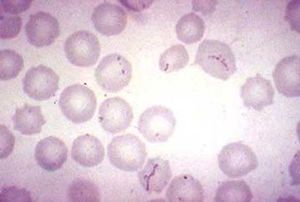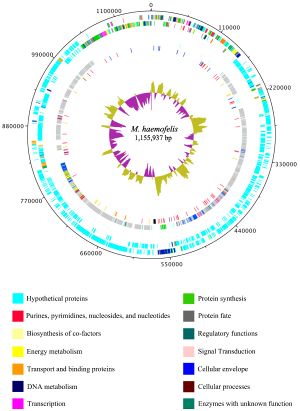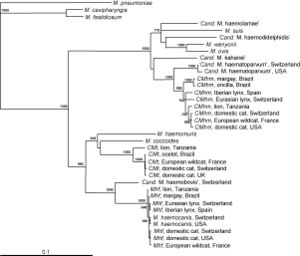Haemobartonella felis: Difference between revisions
Maggiebenson (talk | contribs) No edit summary |
Maggiebenson (talk | contribs) |
||
| Line 51: | Line 51: | ||
==Recent Discoveries== | ==Recent Discoveries== | ||
The ''Mycoplasma haemofelis'' strain Ohio2 was used for genome sequencing in order to understand why the symbiont needs the host for metabolic pathways and resources in order to survive. ''Mycoplasma haemofelis'' relies on it's host because it lacks necessities for pyrimidines metabolism, genes for amino acid metabolism, and other metabolisms. However, this study represents some of the differences that ''Mycoplasma haemofelis'' uses in some other metabolisms. For example, mycoplasmas have been thought to be incapable of fatty acid biosynthesis from acetyl-CoA because of losing genetic material. Yet, this study finds that ''Mycoplamsa haemofelis'' could be able to use glycerol in order to synthesize phospholipids. In addition, this study identified two virulence genes for ''Mycoplasma haemofelis''. One of these is endopeptidase o-sialoglycoprotein, which could contribute to erythrocyte lysis for it cleaves at the glycoproteins. The other one is superoxide dismutase (SOD) gene that may help detoxify reactive oxygen species, which enables the damage to red blood cells. In their research, it is stated that the reduction in the erythrocyte functions results in a short live span of the cells, which then can cause anemia for the host. Also, that the SOD gene can attribute to the survival of ''Mycoplasma haemofelis'' (5). | The ''Mycoplasma haemofelis'' strain Ohio2 was used for genome sequencing in order to understand why the symbiont needs the host for metabolic pathways and resources in order to survive. ''Mycoplasma haemofelis'' relies on it's host because it lacks necessities for pyrimidines metabolism, genes for amino acid metabolism, and other metabolisms. However, this study represents some of the differences that ''Mycoplasma haemofelis'' uses in some other metabolisms. For example, mycoplasmas have been thought to be incapable of fatty acid biosynthesis from acetyl-CoA because of losing genetic material. Yet, this study finds that ''Mycoplamsa haemofelis'' could be able to use glycerol in order to synthesize phospholipids. In addition, this study identified two virulence genes for ''Mycoplasma haemofelis''. One of these is endopeptidase o-sialoglycoprotein, which could contribute to erythrocyte lysis for it cleaves at the glycoproteins. The other one is superoxide dismutase (SOD) gene that may help detoxify reactive oxygen species, which enables the damage to red blood cells. In their research, it is stated that the reduction in the erythrocyte functions results in a short live span of the cells, which then can cause anemia for the host. Also, that the SOD gene can attribute to the survival of ''Mycoplasma haemofelis'' (5). | ||
The sequenced genome of the Langford 1 strain of ''Mycoplasma haemofelis'' showed that this strain is capable of resulting in hemolytic anemia in specific-pathogen-free-derived felines. This was the first hemotropic mycoplasma species to be sequenced and annotated completely. This single, circular genome was 1,147,259 bp and had a GC content of 38.9%. Within the gene content, glucose seemed to be the energy source for the bacteria's glycolysis for the carbohydrate metabolism. In addition, there appeared to be a different mechanism used for purine and pyrimidine metabolism because pentose phosphate pathways were unapparent. Furthermore, there were 31 tRNAs for the amino acids as well as three ribosomal operons. This research can develop on even further and soon answer the question of why this pathogen is meticulous and identify other mechanisms for how it invades the host immune system (1). | The sequenced genome of the Langford 1 strain of ''Mycoplasma haemofelis'' showed that this strain is capable of resulting in hemolytic anemia in specific-pathogen-free-derived felines. This was the first hemotropic mycoplasma species to be sequenced and annotated completely. This single, circular genome was 1,147,259 bp and had a GC content of 38.9%. Within the gene content, glucose seemed to be the energy source for the bacteria's glycolysis for the carbohydrate metabolism. In addition, there appeared to be a different mechanism used for purine and pyrimidine metabolism because pentose phosphate pathways were unapparent. Furthermore, there were 31 tRNAs for the amino acids as well as three ribosomal operons. This research can develop on even further and soon answer the question of why this pathogen is meticulous and identify other mechanisms for how it invades the host immune system (1). | ||
Revision as of 17:01, 3 December 2011
Wiki in progress

Characteristics of the symbiont/pathogen
Haemobartonella felis has been recently renamed to Mycoplasma haemofelis due to a closer relation to the genus Mycoplasma rather than the genus Bartonella (10). The genome of M. haemofelis has been sequenced, and in fact is the first hemotrophic mycoplasma species to be completely sequenced. In a study that compared two strains of the microbe, Ohio2 and Langford 1, they found that the complete genome of the circular chromosome was 1,155,937 base pairs (5). M. haemofelis has a large genome that contains a large number of unique proteins (Figure 2).
The phylogenetic classification of Mycoplasma haemofelis is (4):
- Domain: Bacteria
- Phylum: Tenericutes
- Class: Mollicutes
- Family: Mycoplasmataceae
- Genus: Mycoplasma
- Species: Haemofelis
The cell morphology of Haemobartonella felis, or Mycoplasma haemofelis, is a short coccus- or rod-shaped , gram negative bacteria. It also lacks a cell wall. Because the microbe is unable to be cultured,a microscopic identification from a blood smear is needed for diagnosis (3).

Characteristics of the host
The host for Mycoplasma haemofelis is a feline. It is unclear of what breeds of felines are most commonly effected. However, it is found that felines of older non-pedigree are more at risk for the infection that Mycoplasma haemofelis even though younger felines can be affected (9). In other studies, they found that the infection is more common in felines from regions like Switzerland and other European countries (11).
Host-Symbiont Interaction
The interaction of the host, a feline, and the symbiont, Mycoplasma haemofelis, is one of a parasitic relationship. If the host acquires a relationship with the symbiont, the host will become anemic, which effects the host's red blood cell count. It is unclear of how the symbiont and disease is transmitted. However, some studies suggest that it is transmitted by fleas, so flea control is suggested for felines. Because it is known that the symbiont causes problem in the host's blood, it can be determined that another source of transmission is inoculation of infected blood. One of the symptoms for this disease are pale gums (Figure 3).
Since transmission is unclear, treatments are possible but not known to completely treat anemia for the infected feline. The most commonly used treatment is doxycycline that can be used for 14-21 days with one dosage a day. If the anemic conditions of the host are severe, a blood transfusion may be recommended (7).
The interaction is obligate, because the microbe Mycoplasma haemofelis needs the host in order to carry out specific cellular functions. The class of Mycoplasma haemofelis, Mollicutes, have been studied and determined to be dependent on hosts or other bacterium for guanine phosphoribosyl-transferase activity in order to carry out purine metabolism (9).

Molecular Insights into the Symbiosis
In some recent studies, the species Mycoplasma haemofelis has been compared to two other haemoplasma species, Candidatus M. haemominutum and Candidatus M. turicensis. In comparison of effects on the host of the symbiont, Mycoplasma haemofelis causes haemolysis and Candidatus M. haemominutum does not usually cause anemia. Coombs' tests and blood glucose concentration tests were used to determine the differences between these three species. Coomb's testing determines the presence for erythrocyte-bound antibodies and if the red blood cells become destroyed. The species Mycoplasma haemofelis was the only species that tested positive for Coomb's test. For glucose concentrations, the species Candidatus M. turnicensis had lower concentrations than the other two species as well as lower blood copy numbers. In conclusion of this study, they found that the species Mycoplasma haemofelis was the only to develop macrocytic anemia (6).
Many genes of Mycoplasma haemofelis have been studied. The two genes IMP (inosine-5′-monophosphate) dehydrogenase and GMP (guanosine 3′,5′-monophosphate) synthase have been found to encode proteins and partake in biosynthesis. This is significant because these enzymatic activities of these genes have not been found in Mollicutes. This raises the question if Mycoplasma haemofelis needs a host in order to perform guanine biosynthesis. However, there is not enough research completed in order to determine this. Also, it is not clear what are the enzymes activities. In addition, the gene superoxide dismutase (SOD) is very unique to Mycoplasmas haemofelis because it is not found or sequenced in other mycoplasmas. This gene may suggest that Mycoplasma haemofelis is actually facultative; however, there is no clear evidence of the genes' activity. Furthermore, it is found that this specie has many unique proteins and genes. Because of the unique genes, it is understood that this species of mycoplasma has adapted it self to colonize the red blood cell rather than mucosal surfaces like most mycoplasmas do and this is why it survives in it's host (2).

Ecological and Evolutionary Aspects
In the past decade or so, this microbe has changed from Haemobartonella to Mycoplasma. This has been reclassified because in studies the microbe has been determined to be more related to Mollicutes than Rickettsiales. In addition, Mycoplasma haemofelis is unculturable which makes it difficult to diagnosis. However, with more recent research it is possible to diagnosis for the infection by the polymerase chain reaction (PCR) rather than the older method of studying the red blood cells, which resulted in false positive and false negative due to other factors. These new PCR methods have contributed to the identification of two strains of Mycoplasma haemofelis, Ohio strain and California strain. The difference between these two strains are the presence of anemia in the feline, in which the Ohio strain causes a more severe infection that could result in haemolytic anemia that could become fatal. Since there are strains from different geological regions and most felines affected are found in Europe, this may suggest that environmental factors play a role in regulating the symbiosis. However,Mycoplasma haemofelis is still in the early stages of research because of its difficulty in culturing, so as of now environmental factors are not determined (7).
Recent Discoveries
The Mycoplasma haemofelis strain Ohio2 was used for genome sequencing in order to understand why the symbiont needs the host for metabolic pathways and resources in order to survive. Mycoplasma haemofelis relies on it's host because it lacks necessities for pyrimidines metabolism, genes for amino acid metabolism, and other metabolisms. However, this study represents some of the differences that Mycoplasma haemofelis uses in some other metabolisms. For example, mycoplasmas have been thought to be incapable of fatty acid biosynthesis from acetyl-CoA because of losing genetic material. Yet, this study finds that Mycoplamsa haemofelis could be able to use glycerol in order to synthesize phospholipids. In addition, this study identified two virulence genes for Mycoplasma haemofelis. One of these is endopeptidase o-sialoglycoprotein, which could contribute to erythrocyte lysis for it cleaves at the glycoproteins. The other one is superoxide dismutase (SOD) gene that may help detoxify reactive oxygen species, which enables the damage to red blood cells. In their research, it is stated that the reduction in the erythrocyte functions results in a short live span of the cells, which then can cause anemia for the host. Also, that the SOD gene can attribute to the survival of Mycoplasma haemofelis (5).
The sequenced genome of the Langford 1 strain of Mycoplasma haemofelis showed that this strain is capable of resulting in hemolytic anemia in specific-pathogen-free-derived felines. This was the first hemotropic mycoplasma species to be sequenced and annotated completely. This single, circular genome was 1,147,259 bp and had a GC content of 38.9%. Within the gene content, glucose seemed to be the energy source for the bacteria's glycolysis for the carbohydrate metabolism. In addition, there appeared to be a different mechanism used for purine and pyrimidine metabolism because pentose phosphate pathways were unapparent. Furthermore, there were 31 tRNAs for the amino acids as well as three ribosomal operons. This research can develop on even further and soon answer the question of why this pathogen is meticulous and identify other mechanisms for how it invades the host immune system (1).
References
4. Genome information for Mycoplasma haemofelis. NCBI Website.
Edited by Maggie Benson, students of Grace Lim-Fong
This template is just a general guideline of how to design your site. You are not restricted to this format, so feel free to make changes to the headings and subheadings and to add or remove sections as appropriate.
